|
|||||||||||||||||||||||||||||||||||||||||||||||
|
|
|||||||||||||||||||||||||||||||||||||||||||||||
r - revised
|
Top 10 Philippine Imports from All Countries: July 2006 |
|||
|
Gainers |
Losers |
||
|
Mineral Fuels, Lubricants and Related Materials |
89.7 |
Telecommunication Equipment and Electrical Machinery |
-25.1 |
|
Transport Equipment |
46.4 |
Organic and Inorganic Chemical |
-14.1 |
|
Iron and Steel |
45.7 |
Textile Yarn, Fabrics, Made-Up Articles and Related Products |
-0.1 |
|
Industrial Machinery and Equipment |
17.9 |
||
|
Plastics in Primary and Non-Primary Forms |
12.1 |
||
|
Cereals and Cereal Preparations |
3.4 |
||
|
Electronic Products |
3.1 |
||
January to July 2006 total trade stands at $55.728 billion
Total external trade in goods for January to July in 2006 reached $55.728 billion representing a 12.6 percent increment from $49.473 billion during the same period a year earlier. Similarly, total foreign-made merchandise grew by 9.6 percent to $29.035 billion from $26.498 billion. Exports on the other handl, registered a positive rate at 16.2 percent to aggregate dollar revenue of $26.693 billion from $22.974 billion of the previous year. Balance of trade in goods (BOT-G) deficit for the Philippines reached $2.342 billion, lower compared to last year’s deficit of $3.524 million.
Figure 1A. Philippine Trade Performance in January - July :2005 and 2006
(F.O.B. Value in Million US Dollar)
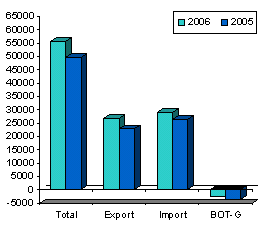
Figure 1B. Philippine Trade Performance in July :2005 - 2006
(F.O.B. Value in Million US Dollar)
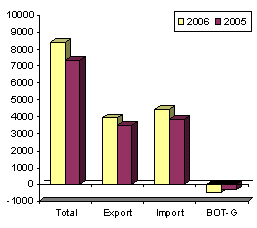
July imports register 16.5 percent increase
Total merchandise trade for July 2006 went up by 14.8 percent to $8.420 billion from $7.336 billion during the same period last year. Dollar-inflow generated by exports reached $3.956 billion, or 12.9 percent higher than last year’s $3.503 billion. In the same way, expenditures for imported goods gained by 16.5 percent to $4.464 billion from $3.833 billion. The balance of trade in goods (BOT-G) registered a deficit at $508 million, higher from last year’s deficit of $330 million.
Electronic products account for 43.6 percent of import bill
Accounting for 43.6 percent of the total aggregate import bill, payments for electronic products amounted to $1.946 billion or a 3.1 percent growth over last year’s figure of $1.888 billion. Compared to the previous month’s level, purchases declined by 4.6 percent from $2.039 billion. Among the major groups of electronic products, components/devices (semiconductors) got the biggest share at 35.2 percent and recorded an increase of 5.6 percent to $1.570 billion from $1.488 billion during the same month in 2005.
Imports of mineral fuels, lubricants and related materials in July ranked second with 17.5 percent share. Expenditures at $782.02 million, posted a double-digit increase at 89.7 percent over the previous year’s level of $412.23 million, as world prices of petroleum oils from bituminous minerals as well as motor spirit (gasoline) went up.
Transport equipment, contributing 4.2 percent to the total bill, was RP’s third top import for the month with payments placed at $189.49 million from last year’s $129.42 million or a year-on-year growth at 46.4 percent. This can be attributed to the increase in the value on components, parts and accessories imported from one or more countries for assembly of passenger cars and other parts of airplanes/helicopters.
Industrial machinery and equipment, accounting for 4.1 percent of the total imports, ranked fourth as foreign bill amounted to $182.27 million from $154.58 million last year. The industry growth of 17.9 percent was brought by the increase in the value of importation of other machines and mechanical appliances and parts.
Iron and steel, comprising 3.0 percent of the total imports, registered a $135.60 million worth of imports from $93.10 million a year earlier. Higher value in the importation of semi-finished products, of iron or non-alloy steel and hot-rolled bars and rods mainly contributed the growth of 45.7 percent.
Expenditures for textile yarn, fabrics, made-up articles and related products, with a 2.4 percent share, posted an imports worth $106.38 million from $106.45 million of the previous year.
Rounding up the list of the top imports for June 2006 were cereals and cereal preparations, with $103.27 million; plastics in primary and non-primary forms, $79.82 million; organic and inorganic chemical, $77.35 million; and telecommunication equipment and electrical machinery, $59.06 million.
Aggregate payment for the country’s top ten imports for July 2006 reached $3.661 billion or 82.0 percent of the total bill.
Figure 2. Philippine Top Imports in July: 2005 and 2006
(F.O.B. Value in Million US Dollar)
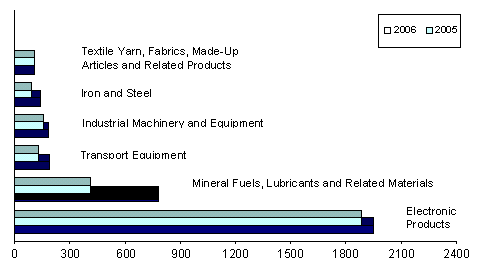
Raw materials and intermediate goods account for 40.2 percent of the total imports
Payments in July for raw materials and intermediate goods accounted for 40.2 percent as importation inched-up by 1.0 percent to $1.796 billion from last year’s figure of $1.778 billion. Semi-processed raw materials got the biggest share of 37.4 percent and valued at $1.668 billion.
Capital goods comprising 32.6 percent of the total imports, was up by 13.9 percent year-on-year to $1.456 billion from $1.279 billion. The major share went to telecommunication equipment and electrical machinery with a 17.9 percent share of the total imports and billed at $801.10 million.
Expenditures for mineral fuels, lubricants and related materials accelerated by 89.7 percent to $782.03 million from $412.23 million during the same period of 2005.
Purchases of consumer goods amounted to $333.19 million, a growth of 17.2 percent from $284.29 million in July 2005, while special transactions gained by 22.6 percent to $97.05 million from $79.17 million.
Figure 3. Philippine Imports by Major Type of Goods in July: 2005 and 2006
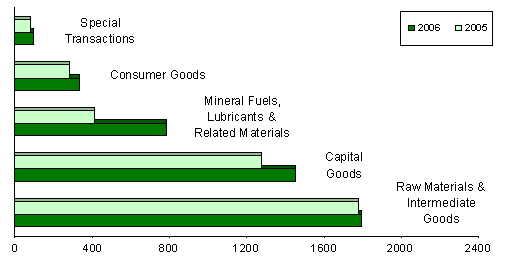
United States corners 15.9 percent of july import bill
Imports from United States accounting for 15.9 percent of the total import bill, dropped by 13.1 percent to $709.23 million from $816.17 million during the same period of 2005. Exports to US, amounted to $757.80 million yielding a two-way trade value of $1.467 billion and a trade surplust for RP placed at $48.57 million.
Japan, the country’s second biggest source of imports for July with a 12.6 percent share, reported shipments billed at $560.54 million against exports earnings of $643.07 million. Total trade amounted to $1.204 billion, with a trade surplus registered at $82.53 million.
Singapore followed as the third biggest source of imports. With payments worth $480.72 million, imports climbed by 67.1 percent from $287.67 million, while revenue from RP’s exports reached $279.05 million resulting to a total trade value of $759.77 million and a $201.67 million deficit for Philippines.
Other major sources of imports for the month of July were People’s Republic of China, $326.92 million; Taiwan, $321.88 million; Iran, $292.69 million; Republic of Korea, $282.98 million; Malaysia, $198.35 million; Hong Kong, $185.87 million; and Germany, $160.11 million.
Payments for imports from the top ten sources for the month amounted to $3.519 billion or 78.8 percent of the total.
Figure 4. Philippine Imports by Country in July: 2006
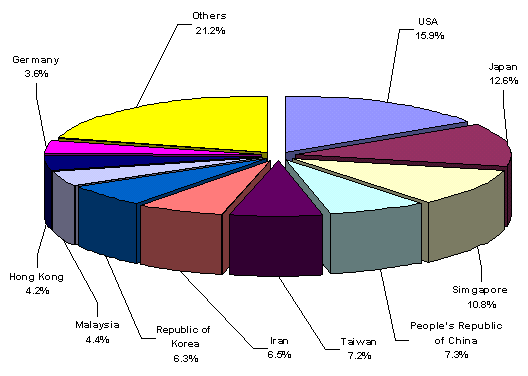
Technical Notes
1. Adjustments on electronics import statistics are based on the approved valuation methodology as per NSCB Resolution No. 8 Series of 2005 and the inclusion of transactions that passes through Automated Cargo Operating System (ACOS).
2. Analysis and Tables 1 to 5 in this Press Release is based on data using the 1993 Philippine Standard Commodity Classification (PSCC) groupings (as amended in 1999).
3. Starting with the July 2006 series of Foreign Trade Statistics (FTS), additional tables (Tables 6 and 7) using the 2004 PSCC groupings are provided.
4. The adoption of the 2004 PSCC is in compliance with NSCB Resolution No. 03, Series of 2005 entitled " Approving and Adopting the 2004 Philippine Standard Commodity Classification" by all concerned government agencies and instrumentalities.
5. In view of the adoption of the new classification system, the NSO shall issue two sets of detailed tables: 7-digit following the 1993 PSCC (as amended in 1999) and 10-digit using the 2004 PSCC simultaneously, until the December 2006 FTS. However, beginning January 2007 FTS, only the 2004 PSCC groupings will be released by NSO.
6. Detailed tables at commodity levels are available upon request from te NSO-Industry and Trade Statistics Department, 10 days after the monthly press release.
|
(Sgd.) CARMELITA N. ERICTA |
Source: National Statistics Office
Manila, Philippines
